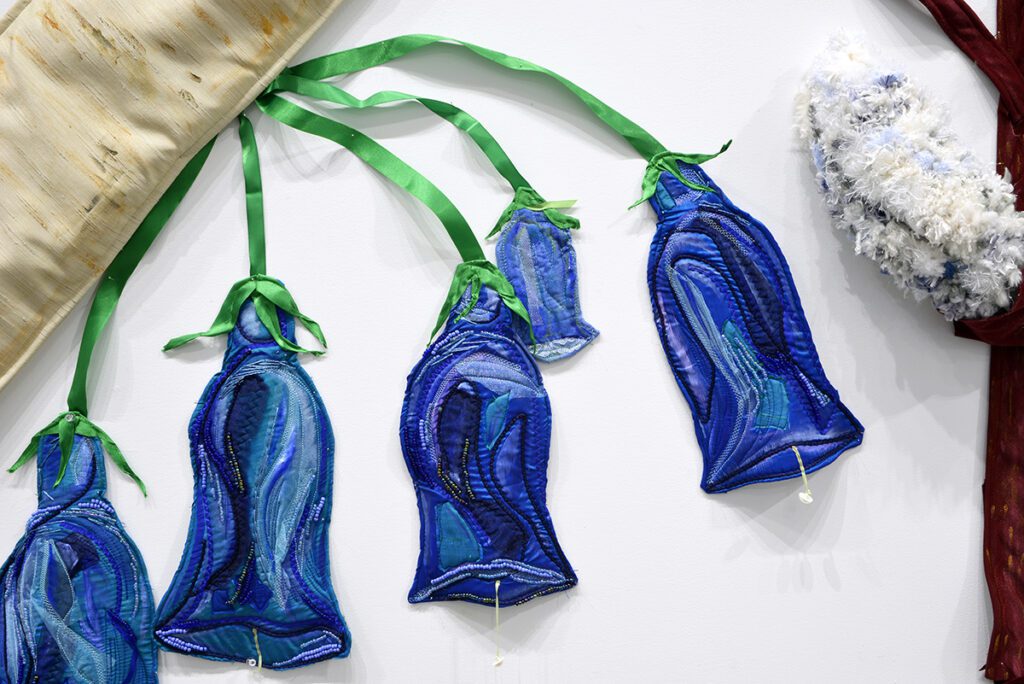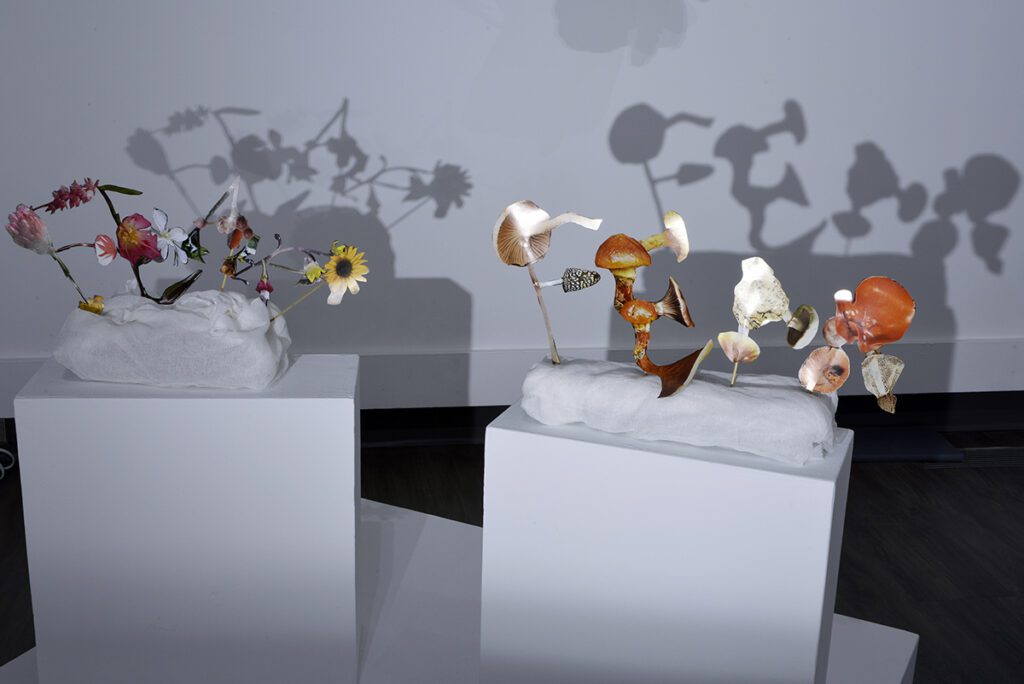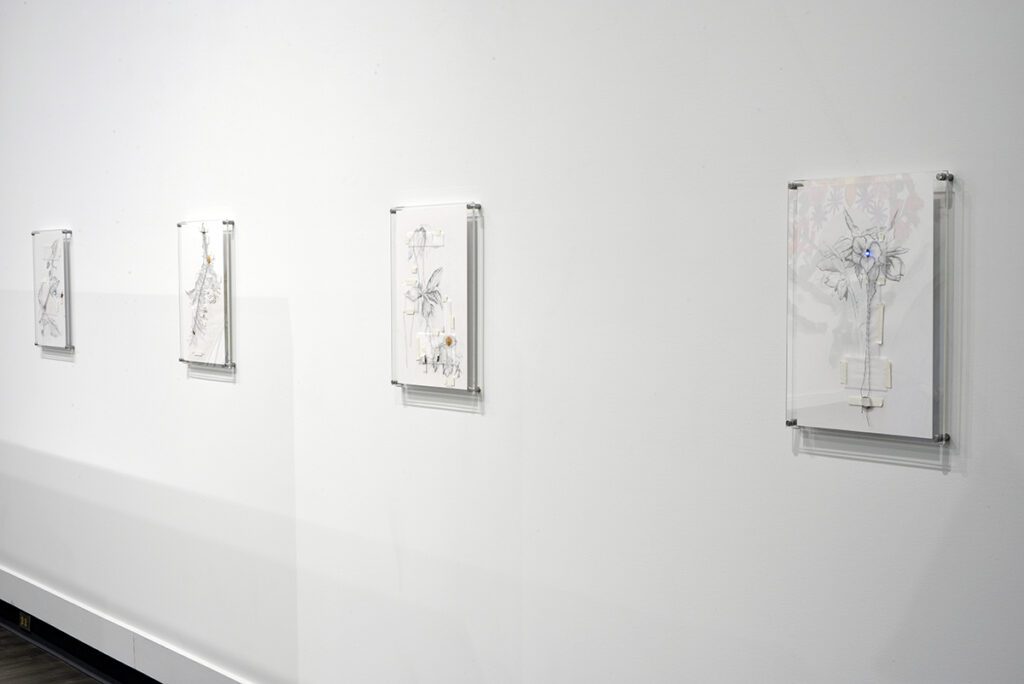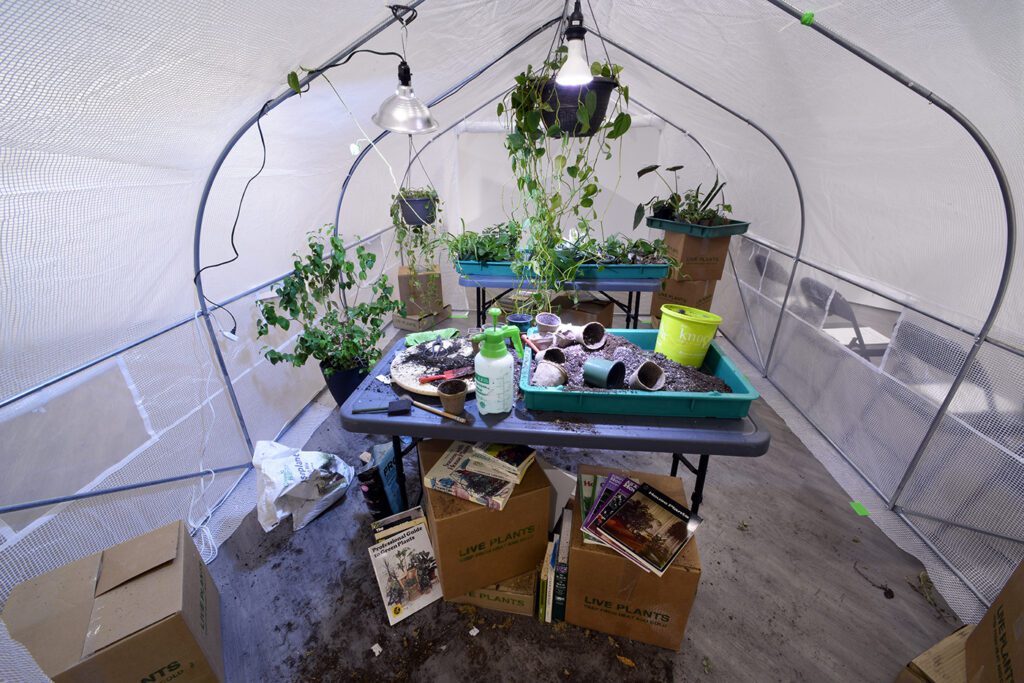We Are All Electric Beings: Inter-species meet-cute at the Art Gallery of Regina
27 February 2024By Jera MacPherson

Last October, I procured a new house plant under unique circumstances. A small Hoja specimen was transferred into my care at the Art Gallery of Regina during a free plant adoption project by artist Alyssa Ellis. During the exhibition’s run, visitors were asked to symbolically enter into an interspecies social contract with their new plants, signing a formal agreement hinged on reciprocal notions of care. Even though the exhibition has long since closed, the themes of the show become ever more imposing—not unlike the plant that continues to grow in my care.
The exchange was part of Ellis’ performance Plant Spa, where a host of plants spent the evening receiving treatments in front of a seated audience. As could be expected, Ellis performed various caretaking strategies to the plants in her collection, such as trimming, dusting, and repotting them as required. But perhaps less expected, Ellis, who dressed in leafy shades and green up-pinned braids, spritzed the plant patients with vitamin-enhanced water as they listened to a compilation of Molly Roth’s Plant Talk from 1976 and Dr. George Milstein’s Music to Grow Plants from 1970, both said to have been composed specifically to soothe house plants.
Ellis’ performance and the subsequent plant adoption project were part of the group exhibition, We Are All Electric Beings curated by the Art Gallery of Regina’s Curator of Exhibitions and Programming Sandee Moore, wherein four artists, including Rachel Broussard, originally from Louisiana and now based on Treaty 6, Alyssa Ellis, based on Treaty 7, Heather Shillinglaw, of Métis ancestry hailing from Treaty 6, and Laurel Terlesky who is based on Treaty 8, were brought together to reflect on human relationships with plant life and the environment. Given the predominantly settler and immigrant make-up of the exhibiting artists, the heart of the exhibition’s theme relies heavily on one artist in particular to indigenize the complexities of the conversations on plant-human relationships, as inseparable from the relationship Indigenous peoples have had with the land and the local plant life since time immemorial.

Artist Heather Shillinglaw traveled and worked with her mother, Elder Shirley Norris Shillinglaw of Cold Lake First Nation, learning the Nêhiyawêwin names of medicinal prairie plants that her matrilineal ancestors—who trace back to the region near Cooking Lake in Northern Alberta—would have carried in their medicine bags. Not long after I met Shillinglaw, the artist frankly described her new works to me as “quilting on steroids,” in reference to the two backless large-scale quilts the artist had freshly completed for inclusion in the exhibition, each extending twelve-feet high towards the ceiling.
By picking up a needle and thread for the production of this new series, Shillinglaw explained that these tools have become an umbilical-like tether to her matrilineal ancestors. For example, in nânitawâpamêw sakâw nâtawihowin (2022) which translates to “she searches for forest medicines,” a glistening yarrow plant framed by two towering tamarack blooms energetically emerges from a composition of moss, flowers, sacs, and leaves. In an artist discussion organized by the Art Gallery of Regina in conversation with Dr. Mel Hart, a member of the George F. Ledingham Herbarium committee at the University of Regina, Shillinglaw shared how from a young age, she would have her skinned knees treated with the leaves of the common yarrow, applied by her mother much like a band-aid, providing relief and comfort.1 Similarly, her quilted works in the exhibition gesture towards this generational act of care and further binds together the relationship between Indigenous people, plants, and care in the exhibition.
Having procured my small Hoja from Ellis’ performance in such an unconventional, art-related way, was a reminder that the history of plant collecting has not always been as thoughtful or intentional. Botany, as we know it, emerged as a European field of study spurred by colonial European explorations, and relied on the subsequent exploitation of humans and plant species in the Victorian era. Inventions such as the Wardian case—a big terrarium—afforded plants the ability to travel long distances under sealed conditions.2 This colonial impulse to invade, take, and then display back in their homeland explains why tropical and semi-tropical plants are the most popular houseplants today, in spite of not being regionally specific to Canada. They live indoor, pot-restricted lives simply to survive.
Collectors’ relationship to plants as aesthetic objects and status symbols heavily mirror the power dynamics of art history in terms of practices of collecting and display typified by UK-based artist Céline Condorelli, whose 2018 research-driven print series Plant Studies catalogs specific plant varieties “displayed” in the New York’s MoMA during the 1950s through the 1970s, identifying them as uncredited elements of past exhibitions. Part of the interdisciplinary work of the project narrowed in on the colonial histories of how these plants came to be collected and named. She writes that, “Houseplants, like most of the museum apparatus of visibility, do not appear in the history of art and yet have shared spaces with artworks throughout the history of exhibitions.”3

Instead of reflecting in the vein of revisionist art history, the staging and in-gallery activation of Alyssa Ellis’ plant-life collaborators figured prominently into the curatorial vision of the exhibition. Moreover, the exhibiting artists of We are All Electric Beings critically engaged with the problematic notions of colonial collecting practices, even if this included facing connected anxieties such as the art sector’s contribution to climate-change. In the work aptly titled Climate Anxiety (2022), Rachel Broussard’s collage sculptures, made up of images of now at-risk wildlife sourced from archival issues of National Geographic, are arranged in such a way as to cast the word “fear” multiple times on the gallery wall in shadow.
The exhibition’s theme of interdependence was resurfaced in an experiential way in Laurel Teresky’s series, Tenacity of Hope (2022), a series of plant-referential drawings and rope-like ceramic sculptures, cast from salal, a type of evergreen shrub found in the prairies. Visitors were invited to touch the surface of the drawings or noodle the drape of the sculpture causing them to light up from within when touched, even gently. The exhibition’s curator Sandee Moore voices that, “In some ways, the dull clatter of the clay leaves when the rope is tugged is like sounding an alarm bell: we should wake up to how our actions impact our environment.”4
In the same year as We are All Electric Beings was mounted with brand new work by four contemporary prairie-based artists on topic of environment and plant-life, a text by radical French activist Françoise d’Eaubonne who first coined the term “eco-feminist” was translated into English for the very first time, thanks to Ruth Hottell.5 Originally published in 1974, Le féminism ou la mort loudly places the upholding of patriarchal society and capitalism at the root of the oppression of both women and the planet. In arguing that the survival of the planet is interwoven with feminism’s fight for equality, d’Eaubonne insists that the undoing of a male-dominated, capitalism-crazed society obsessed with limiting reproductive rights would also slow the overexploitation of the planet.6

Although d’Eaubonne’s original theories don’t take long to drift into exclusionary and essentializing thinking patterns, the resurgence interest in eco-feminism exhibits a parallel and timely outrage at the exploitation of the planet’s resources, destruction of whole ecosystems, attacks on reproductive justice, and neglect for Indigenous sovereignty—all interlaced actions taken by powers who rely on the maintenance of the established dual structures of capitalism and colonialism.
Alternatively, Robin Wall Kimmerer, a Potawatomi botanist and one of the voices visioning a future for environmental stewardship that champions traditional ecological knowledge, speaks of production and consumption in this way: “In their first few days, leaves are consumers, taking from the root, shriveling it up and giving nothing back. But as they unfurl they become a powerful solar array that will recharge the energy of the roots, playing out the reciprocity between consuming and producing in a few short weeks.”7
As an exhibition, We Are All Electric Beings encourages non-hierarchical interspecies interaction and thinking that centres the lives of humans and plants, and their fundamental interdependence and mutual need to be nurtured. I recently repotted the Hoja I adopted, as it had outgrown the small pot I’d originally brought to the Art Gallery of Regina. As it, and the other vessel-bound plants improve the air quality and visual appeal of my apartment, I hope that I too have pushed bit-by-bit against some of the restrictive encasings of my own capitalist-colonial conditions best articulated through such similarly simple reciprocal acts of care.
- “How Artists and Scientists See Plants.” Artist Talk, Art Gallery of Regina, filmed September 28, 2022.Video recording, 1:38:17. www.youtube.com/watch?v=Khkwo2PYLSk&t=2s.
- Luke Keogh, “The Wardian Case: How a Simple Box Moved the Plant Kingdom,” Arnoldia no. 74 (2017), https://arboretum.harvard.edu/stories/the-wardian-case-how-a-simple-box-moved-the-plant-kingdom/.
- Céline Condorelli, “Zanzibar (2019).” Artist Website, accessed June 1, 2023: https://celinecondorelli.eu/text/zanzibar.
- Sandee Moore, We are All Electric Beings Audio Tour Transcript, Art Gallery of Regina, Accessed June 15, 2023: https://www.artgalleryofregina.ca/we-are-all-all-electric-beings.
- Françoise d’Eaubonne, Le féminisme ou la mort, (Paris: P. Horay, 1974).
- In 1971, Francoise d’Eaubonne signed the Manifesto of the 343 written by Simone de Beauvoir, wherein 343 people declared having had an illegal abortion in protest of dangerous French laws at the time.
- Robin Wall Kimmerer, Braiding Sweetgrass: Indigenous Wisdom, Scientific Knowledge, and the Teachings of Plants, (Minneapolis: Milkweed Editions, 2013), 178.
We are All Electric Beings ran from October 13, 2022 – January 8, 2023 at the Art Gallery of Regina in Regina, SK.
Feature Image: Detail of Plant Spa, 2022 by Alyssa Ellis. Photo by Don Hall courtesy of the Art Gallery of Regina.



